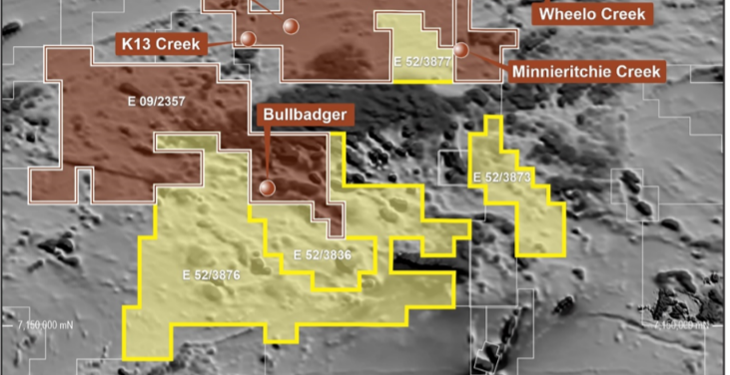Krakatoa Resources Limited (ASX: KTA) has identified a maiden Exploration Target at the Tower prospect, representing just one of many prospective ionic clay REE prospects at its 100% owned Mt Clere project located in the north-western margins of the Yilgarn Craton, Western Australia.
Based on recent drilling and geological interpretation the Exploration Target has been estimated at: 87 to 519 million tonnes grading 580-1120 ppm TREO.
“The discovery of clay hosted REE’s is now enhanced with the substantial prospective Exploration Target,” CEO, Mark Major, said.
“It is a very exciting milestone and represents a major step forward for shareholders. This could well be one of the largest clay hosted REE deposits within the southern hemisphere.
“We have only explored one of the many clay hosted REE areas identified within the extensive land package at Mt Clere. We are looking forward to the resumption of the drilling programme where we will infill and extend the known areas of clay hosted REE as we work on completing the initial metallurgical review.”
Exploration Target
The Exploration target for the Tower prospect has been estimated using modelling of the recently completed 39 vertical reconnaissance air core (AC) drill holes assay results with the projection of the mineralisation extending over adjoining geologically prospective areas that have similar basement geology, regolith development, radiometric and spectral indices.
The grade and thickness of the mineralisation in these exploration target areas is determined from recent drilling and regolith mapping.
The geological regolith model was constrained by the limits of the topography, geological signature based on the results of the recent drilling which consisted of 39 vertical holes (1,047m). The geological zones highly likely to contain the clay hosted REE mineralisation are interpreted to be areas where alkaline granitic and gneissic basement rocks have well developed thick pallid clay zones.
On the flat tops of the topographic highs a well-developed thick lateritic cap is present. This cap is less prominent or absent further down topographical gradient due to erosion. It is postulated that the lower (deeper) more REE enriched clay saprolite zones closer to the basement are still present in the areas of the exploration target.
The modelled target volume outside the area of the current drilling was scaled back to accommodate for any changes within the regolith mineral zonation, specifically the thickness of the mineralised zone. A reduction of thickness of up to a third (~6m) of that found in the drilled zones was used for the target estimation.
Rare Earth Element Discovery Programme
Krakatoa completed 39 vertical reconnaissance air core (AC) drill holes (1,047 meters) around the Tower prospect in December 2021. The aim of the Tower prospect reconnaissance drilling was to investigate and test for well-developed clay-rich regolith profiles that could be prospective for ion adsorption clay (IAC) REE mineralisation.
The area tested was around six sq. km. Samples were collected each metre and combined into four metre composite samples from surface. End of hole samples composites varied from 1.0 to 4.0 metres, dependent on the depth encountered.
Majority of the holes intersected the expected bedrock of alkaline granitic and gneissic basement rocks with the pallid clay zones being well developed and having thickness from 10 to 30 plus metres. One hole encountered bedrock at 3.0 metres.
Samples were assayed using two methods of sample digestion; a near complete digestion (Lithium Borate Fusion method) and a second representing only the leachable portion of the sample (weak aqua regia (WAR) method).
Results
The analytical results revealed significant levels of widespread REEs, with abundant quantities of magnetic and critical rare earth elements. The company received the initial batch of assay results and reported these on the April 12, 2022.
These additional drill hole assays are consistent with the initial samples results. Critical REO (CREO) and magnetic REO (MREO) concentrations as well as uranium (U) and thorium (Th).
The clay intersection of >500ppm TREO range in thickness from 4.0m to 33m within the current area of drilling. Several holes within both Tower and Tower West areas did not have intersections >500ppm TREO; most of these holes exhibited level of greater than 200ppm TREO with only drill holes 21MAC006 and 21MAC013 recording no intersection of greater than 200ppm TREO.
Zirconium oxide was also elevated within several zones of the regolith, with several assays higher than 1000ppm returned and an average of 553 within intervals >200ppm TREO.
Uranium and Thorium levels are low which is expected with ionic clay hosted REE deposits. They averaged 1.09ppm (U) and 38ppm (Th) respectively for >200ppm TREO intervals.
The main mineralisation envelopes are interpretated to lie within the large horizontal clay saprolite layer and are open to the north, east and west. Additional areas within the laterite caprock and within the highly weathered saprock have also shown significant REE mineralisation.
For further information please visit: https://www.ktaresources.com/












